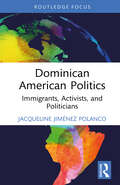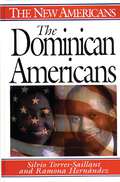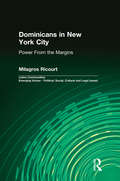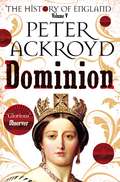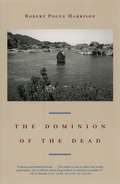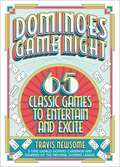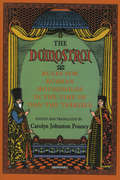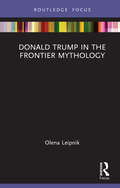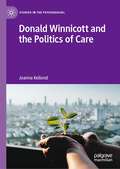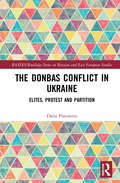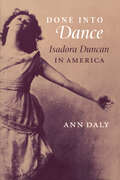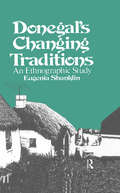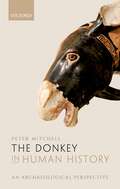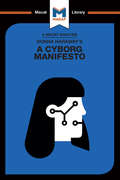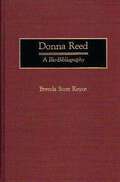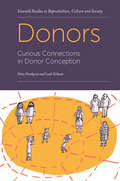- Table View
- List View
Dominican American Politics: Immigrants, Activists, and Politicians (Routledge Research in American Politics and Governance)
by Jacqueline Jiménez PolancoIn this book, Jacqueline Jiménez Polanco examines the politics of empowerment of Dominican Americans in the United States. Covering the first two decades of the twenty-first century, Jiménez Polanco provides a new analytical perspective to understand the political development of a growing ethnic community that has been historically neglected in the studies of Latino/a/x political development and whose peculiar characteristics represent a paradigmatic case that debunks pervading theories about immigrant communities’ participation and representation in U.S. electoral politics. Rich archival research and interviews with key Dominican American leaders and activists shed light on how some patterns followed by Dominican Americans in their political empowerment correspond to those of other Latino/a/x communities, while other patterns distinctly diverge from that common trend. Dominican American Politics: Immigrants, Activists, and Politicians serves as a perfect companion for courses on Latino/a/x and Dominican studies and U.S. ethnic politics.
Dominican American Politics: Immigrants, Activists, and Politicians (Routledge Research in American Politics and Governance)
by Jacqueline Jiménez PolancoIn this book, Jacqueline Jiménez Polanco examines the politics of empowerment of Dominican Americans in the United States. Covering the first two decades of the twenty-first century, Jiménez Polanco provides a new analytical perspective to understand the political development of a growing ethnic community that has been historically neglected in the studies of Latino/a/x political development and whose peculiar characteristics represent a paradigmatic case that debunks pervading theories about immigrant communities’ participation and representation in U.S. electoral politics. Rich archival research and interviews with key Dominican American leaders and activists shed light on how some patterns followed by Dominican Americans in their political empowerment correspond to those of other Latino/a/x communities, while other patterns distinctly diverge from that common trend. Dominican American Politics: Immigrants, Activists, and Politicians serves as a perfect companion for courses on Latino/a/x and Dominican studies and U.S. ethnic politics.
The Dominican Americans (The New Americans)
by Ramona Hernandez Silvio Torres-SaillantThis profile of Dominican Americans closes a critical gap in information about the accomplishments of one of the largest immigrant groups in the United States. Beginning with a look at the historical background and the roots of native Dominicans, this book then carries the reader through the age-old romance of U.S. and Dominican relations. With great detail and clarity, the authors explain why the Dominicans left their land and came to the United States. The book includes discussions of education, health issues, drugs and violence, the visual and performing arts, popular music, faith, food, gender, and race. Most important, this book assesses how Dominicans have adapted to America, and highlights their losses and gains. The work concludes with an evaluation of Dominicans' achievements since their arrival as a group three decades ago and shows how they envision their continued participation in American life. Biographical profiles of many notable Dominican Americans such as artists, sports greats, musicians, lawyers, novelists, actors, and activists, highlight the text.The authors have created a novel book as they are the first to examine Dominicans as an ethnic minority in the United States and highlight the community's trials and tribulations as it faces the challenge of survival in a economically competitive, politically complex, and culturally diverse society. Students and interested readers will be engaged by the economic and political ties that have attached Americans to Dominicans and Dominicans to Americans for approximately 150 years. While massive immigration of Dominicans to the United States began in the 1960s, a history of previous contact between the two nations has enabled the development of Dominicans as a significant component of the U.S. population. Readers will also understand the political and economic causes of Dominican emigration and the active role the United States government had in stimulating Dominican immigration to the United States. This book traces the advances of Dominicans toward political empowerment and summarizes the cultural expressions, the survival strategies, and the overall adaptation of Dominicans to American life.
Dominicans in New York City: Power From the Margins (Latino Communities: Emerging Voices - Political, Social, Cultural and Legal Issues)
by Milagros RicourtThis volume forms part of the Latino Communities, Emerging Voices Political, Social, Cultural and Legal Issues series. This study explores the diverse struggles of incorporation pursued by immigrants from the Dominican Republic to one city in the United States- New York City. The Dominican Republic, the second largest country of the Greater Antilles in the Caribbean Sea, was the nation that sent the most immigrants to New York City during the 1980s and 1990s. This study chronicles the lives of Dominicans in New York City: their difficulties, their courage, and their boldness to incorporate themselves into American politics.
Dominicans in New York City: Power From the Margins (Latino Communities: Emerging Voices - Political, Social, Cultural and Legal Issues)
by Milagros RicourtThis volume forms part of the Latino Communities, Emerging Voices Political, Social, Cultural and Legal Issues series. This study explores the diverse struggles of incorporation pursued by immigrants from the Dominican Republic to one city in the United States- New York City. The Dominican Republic, the second largest country of the Greater Antilles in the Caribbean Sea, was the nation that sent the most immigrants to New York City during the 1980s and 1990s. This study chronicles the lives of Dominicans in New York City: their difficulties, their courage, and their boldness to incorporate themselves into American politics.
Dominion: A History of England Volume V (The History of England #5)
by Peter Ackroyd'Ackroyd makes history accessible to the layman' - Ian Thomson, IndependentThe penultimate volume of Peter Ackroyd’s masterful History of England series, Dominion begins in 1815 as national glory following the Battle of Waterloo gives way to post-war depression, spanning the last years of the Regency to the death of Queen Victoria in January 1901.In it, Ackroyd takes us from the accession of the profligate George IV whose government was steered by Lord Liverpool, who was firmly set against reform, to the reign of his brother, William IV, the 'Sailor King', whose reign saw the modernization of the political system and the abolition of slavery. But it was the accession of Queen Victoria, aged only eighteen, that sparked an era of enormous innovation. Technological progress – from steam railways to the first telegram – swept the nation and the finest inventions were showcased at the first Great Exhibition in 1851. The emergence of the middle classes changed the shape of society and scientific advances changed the old pieties of the Church of England, and spread secular ideas across the nation. But though intense industrialization brought boom times for the factory owners, the working classes were still subjected to poor housing, long working hours and dire poverty.It was a time that saw a flowering of great literature, too. As the Georgian era gave way to that of Victoria, readers could delight not only in the work of Byron, Shelley and Wordsworth but also the great nineteenth-century novelists: the Brontë sisters, George Eliot, Mrs Gaskell, Thackeray, and, of course, Dickens, whose work has become synonymous with Victorian England.Nor was Victorian expansionism confined to Britain alone. By the end of Victoria’s reign, the Queen was also an Empress and the British Empire dominated much of the globe. And, as Ackroyd shows in this richly populated, vividly told account, Britannia really did seem to rule the waves.
The Dominion of the Dead
by Robert Pogue HarrisonHow do the living maintain relations to the dead? Why do we bury people when they die? And what is at stake when we do? In The Dominion of the Dead, Robert Pogue Harrison considers the supreme importance of these questions to Western civilization, exploring the many places where the dead cohabit the world of the living—the graves, images, literature, architecture, and monuments that house the dead in their afterlife among us. This elegantly conceived work devotes particular attention to the practice of burial. Harrison contends that we bury our dead to humanize the lands where we build our present and imagine our future. As long as the dead are interred in graves and tombs, they never truly depart from this world, but remain, if only symbolically, among the living. Spanning a broad range of examples, from the graves of our first human ancestors to the empty tomb of the Gospels to the Vietnam Veterans Memorial, Harrison also considers the authority of predecessors in both modern and premodern societies. Through inspired readings of major writers and thinkers such as Vico, Virgil, Dante, Pater, Nietzsche, Heidegger, and Rilke, he argues that the buried dead form an essential foundation where future generations can retrieve their past, while burial grounds provide an important bedrock where past generations can preserve their legacy for the unborn. The Dominion of the Dead is a profound meditation on how the thought of death shapes the communion of the living. A work of enormous scope, intellect, and imagination, this book will speak to all who have suffered grief and loss.
The Dominion of the Dead (Historical Studies Of Urban America Ser.)
by Robert Pogue HarrisonHow do the living maintain relations to the dead? Why do we bury people when they die? And what is at stake when we do? In The Dominion of the Dead, Robert Pogue Harrison considers the supreme importance of these questions to Western civilization, exploring the many places where the dead cohabit the world of the living—the graves, images, literature, architecture, and monuments that house the dead in their afterlife among us. This elegantly conceived work devotes particular attention to the practice of burial. Harrison contends that we bury our dead to humanize the lands where we build our present and imagine our future. As long as the dead are interred in graves and tombs, they never truly depart from this world, but remain, if only symbolically, among the living. Spanning a broad range of examples, from the graves of our first human ancestors to the empty tomb of the Gospels to the Vietnam Veterans Memorial, Harrison also considers the authority of predecessors in both modern and premodern societies. Through inspired readings of major writers and thinkers such as Vico, Virgil, Dante, Pater, Nietzsche, Heidegger, and Rilke, he argues that the buried dead form an essential foundation where future generations can retrieve their past, while burial grounds provide an important bedrock where past generations can preserve their legacy for the unborn. The Dominion of the Dead is a profound meditation on how the thought of death shapes the communion of the living. A work of enormous scope, intellect, and imagination, this book will speak to all who have suffered grief and loss.
The Dominion of the Dead
by Robert Pogue HarrisonHow do the living maintain relations to the dead? Why do we bury people when they die? And what is at stake when we do? In The Dominion of the Dead, Robert Pogue Harrison considers the supreme importance of these questions to Western civilization, exploring the many places where the dead cohabit the world of the living—the graves, images, literature, architecture, and monuments that house the dead in their afterlife among us. This elegantly conceived work devotes particular attention to the practice of burial. Harrison contends that we bury our dead to humanize the lands where we build our present and imagine our future. As long as the dead are interred in graves and tombs, they never truly depart from this world, but remain, if only symbolically, among the living. Spanning a broad range of examples, from the graves of our first human ancestors to the empty tomb of the Gospels to the Vietnam Veterans Memorial, Harrison also considers the authority of predecessors in both modern and premodern societies. Through inspired readings of major writers and thinkers such as Vico, Virgil, Dante, Pater, Nietzsche, Heidegger, and Rilke, he argues that the buried dead form an essential foundation where future generations can retrieve their past, while burial grounds provide an important bedrock where past generations can preserve their legacy for the unborn. The Dominion of the Dead is a profound meditation on how the thought of death shapes the communion of the living. A work of enormous scope, intellect, and imagination, this book will speak to all who have suffered grief and loss.
Dominoes Game Night: 65 Classic Games to Entertain and Excite
by Travis NewsomeIn this comprehensive guide, a 3-time World Domino Champion breaks down the fascinating history and culture of one of the world's most popular pastimes—and shares how-to instructions for playing 65 different domino games. Featuring step-by-step, illustrated instructions, Dominoes Game Night will teach readers how to play 65 different domino games, including popular variations like Matador, Muggins, Chicken Foot, and Mexican Train. In addition to providing the rules of standard game play, Dominoes Game Night also delves into the 1,000+ year history and culture of the game across the world, and it looks at modern day domino tournaments that are played both in person and online. Also touching on more idiosyncratic domino uses like toppling, Dominoes Game Night introduces readers to the countless benefits of playing Dominoes—like improved memory retention and concentration—while also teaching discipline and bolstering social interactions. With a breakdown of Dominoes terms, rules, and turn-by-turn examples, this book explains the reasoning behind making specific plays, and it takes an in-depth look at the critical thinking and deductive reasoning skills that are required to master the game. Whether you're a novice who is just learning to play, or an experienced player looking to elevate your game, Dominoes Game Night offers all the tools you need to consistently win games at a higher level. Written by a 3-time World Domino Champion, Dominoes Game Night is sure to become the go-to companion for both casual players and Domino die-hards.
Dominoes Game Night: 65 Classic Games to Entertain and Excite
by Travis NewsomeIn this comprehensive guide, a 3-time World Domino Champion breaks down the fascinating history and culture of one of the world's most popular pastimes—and shares how-to instructions for playing 65 different domino games. Featuring step-by-step, illustrated instructions, Dominoes Game Night will teach readers how to play 65 different domino games, including popular variations like Matador, Muggins, Chicken Foot, and Mexican Train. In addition to providing the rules of standard game play, Dominoes Game Night also delves into the 1,000+ year history and culture of the game across the world, and it looks at modern day domino tournaments that are played both in person and online. Also touching on more idiosyncratic domino uses like toppling, Dominoes Game Night introduces readers to the countless benefits of playing Dominoes—like improved memory retention and concentration—while also teaching discipline and bolstering social interactions. With a breakdown of Dominoes terms, rules, and turn-by-turn examples, this book explains the reasoning behind making specific plays, and it takes an in-depth look at the critical thinking and deductive reasoning skills that are required to master the game. Whether you're a novice who is just learning to play, or an experienced player looking to elevate your game, Dominoes Game Night offers all the tools you need to consistently win games at a higher level. Written by a 3-time World Domino Champion, Dominoes Game Night is sure to become the go-to companion for both casual players and Domino die-hards.
The "Domostroi": Rules for Russian Households in the Time of Ivan the Terrible
by Carolyn Johnston PouncyWinner of the 1994 Heldt Prize from the Association of Women in Slavic StudiesA detailed and colorful instruction manual on household management in sixteenth-century Russia, the Domostroi gives a fascinating glimpse of the world of the nobility. This "how-to" guide is one of the few sources on the social history and secular life of Russia in the time of Ivan the Terrible. Carolyn Johnston Pouncy here offers, with an informative introduction, the first complete English translation.
Donald Trump in the Frontier Mythology (Routledge Studies in Media, Communication, and Politics)
by Olena LeipnikThis book explores the presidential image of Donald Trump as it is constructed by the media within American national mythology, precisely the frontier myth. By offering an account of three milestones in the development of the frontier mythology in its intersection with presidential imagery, the book shows how the image of Donald Trump fits into the line of "cowboy presidents," together with Theodore Roosevelt and Ronald Reagan. It also offers insights into the reasons for making Russian president Vladimir Putin a part of Trump’s story and a routinely mentioned figure in American presidential politics. Applying the means of philosophical anthropology to this topical issue at the intersection of politics and the media, this volume will appeal to those working and studying in the areas of media studies, political anthropology, American studies, and myth studies.
Donald Trump in the Frontier Mythology (Routledge Studies in Media, Communication, and Politics)
by Olena LeipnikThis book explores the presidential image of Donald Trump as it is constructed by the media within American national mythology, precisely the frontier myth. By offering an account of three milestones in the development of the frontier mythology in its intersection with presidential imagery, the book shows how the image of Donald Trump fits into the line of "cowboy presidents," together with Theodore Roosevelt and Ronald Reagan. It also offers insights into the reasons for making Russian president Vladimir Putin a part of Trump’s story and a routinely mentioned figure in American presidential politics. Applying the means of philosophical anthropology to this topical issue at the intersection of politics and the media, this volume will appeal to those working and studying in the areas of media studies, political anthropology, American studies, and myth studies.
Donald Winnicott and the Politics of Care (Studies in the Psychosocial)
by Joanna KellondThis book explores the significance of psychoanalyst Donald Winnicott’s ideas for contemporary debates about care. Locating Winnicott in relation to a range of fields, including psychology, philosophy, sociology, critical theory and feminist theory, it examines the implications of his thinking for understanding and transforming the relationship between care and society. Winnicott was unique amongst psychoanalysts for the emphasis he placed on care in the development of subjectivity. The book unpacks Winnicott’s understanding of care and assesses its relevance for conceptions of social responsibility, justice and transformation. In a world where care is in crisis, how might we theorise the conditions necessary for the development of caring subjectivities, and is it possible to infer a relationship between those conditions and progressive social change? This unique book will be of interest to readers in psychosocial studies, politics and anyone concerned with thinking about the relationship between care and social transformation.
The Donbas Conflict in Ukraine: Elites, Protest, and Partition (BASEES/Routledge Series on Russian and East European Studies)
by Daria PlatonovaThis book examines why, when the conflict in eastern Ukraine began in 2014, fighting broke out in the Donets’k region, whereas it did not in Kharkiv city, despite the city, like the Donets’k region, being geographically proximate to Russia and similar in ethnic and linguistic make up. Based on extensive original research, the book argues that a key factor was the nature and behaviour of local elites, with those in Kharkiv having diffuse ties to the centre and therefore being more capable of adapting to sudden, profound regime change at the centre, whereas the elites in the Donets’k region had much more concentrated ties to the centre, were dependent on one network, and therefore were much less able to cope with change. The book thereby demonstrates how crucial for Ukraine are patronal politics, patronage networks, and informal centre-region relations, and that it was these local political circumstances, rather than Russia, which brought about the conflict.
The Donbas Conflict in Ukraine: Elites, Protest, and Partition (BASEES/Routledge Series on Russian and East European Studies)
by Daria PlatonovaThis book examines why, when the conflict in eastern Ukraine began in 2014, fighting broke out in the Donets’k region, whereas it did not in Kharkiv city, despite the city, like the Donets’k region, being geographically proximate to Russia and similar in ethnic and linguistic make up. Based on extensive original research, the book argues that a key factor was the nature and behaviour of local elites, with those in Kharkiv having diffuse ties to the centre and therefore being more capable of adapting to sudden, profound regime change at the centre, whereas the elites in the Donets’k region had much more concentrated ties to the centre, were dependent on one network, and therefore were much less able to cope with change. The book thereby demonstrates how crucial for Ukraine are patronal politics, patronage networks, and informal centre-region relations, and that it was these local political circumstances, rather than Russia, which brought about the conflict.
Done into Dance: Isadora Duncan in America (pdf)
by Ann DalyThis cultural study of modern dance icon Isadora Duncan is the first to place her within the thought, politics and art of her time. Duncan's dancing earned her international fame and influenced generations of American girls and women, yet the romantic myth that surrounds her has left some questions unanswered: What did her audiences see on stage, and how did they respond? What dreams and fears of theirs did she play out? Why, in short, was Duncan's dancing so compelling? First published in 1995 and now back in print, Done into Dance reveals Duncan enmeshed in social and cultural currents of her time — the moralism of the Progressive Era, the artistic radicalism of prewar Greenwich Village, the xenophobia of the 1920s, her association with feminism and her racial notion of "Americanness."
Donegal's Changing Traditions: An Ethnographic Study (The Library of Anthropology)
by Eugenia ShanklinFirst Published in 1985. One of the notable objectives of the Library of Anthropology is to provide a vehicle for the expression in print of new, controversial, and seemingly unorthodox theoretical, methodological, and philosophical approaches to anthropological data. This is a book about traditions that are changing, not languishing in a moribund state and not dead, as other scholars have suggested, but changing to fit present circumstances. Since many people think of traditions as static or immutable, the author’s assertion that traditions are changing may strike readers as paradoxical, but this book deals with a paradoxical people, the Irish of Southwest Donegal, who simultaneously guard and manipulate their traditions: guarding them against the encroachments of the modern world and manipulating them for their own advantage in that world.
Donegal's Changing Traditions: An Ethnographic Study (The Library of Anthropology #Vol. 8)
by Eugenia ShanklinFirst Published in 1985. One of the notable objectives of the Library of Anthropology is to provide a vehicle for the expression in print of new, controversial, and seemingly unorthodox theoretical, methodological, and philosophical approaches to anthropological data. This is a book about traditions that are changing, not languishing in a moribund state and not dead, as other scholars have suggested, but changing to fit present circumstances. Since many people think of traditions as static or immutable, the author’s assertion that traditions are changing may strike readers as paradoxical, but this book deals with a paradoxical people, the Irish of Southwest Donegal, who simultaneously guard and manipulate their traditions: guarding them against the encroachments of the modern world and manipulating them for their own advantage in that world.
The Donkey in Human History: An Archaeological Perspective
by Peter MitchellDonkeys carried Christ into Jerusalem while in Greek myth they transported Hephaistos up to Mount Olympos and Dionysos into battle against the Giants. They were probably the first animals that people ever rode, as well as the first used on a large-scale as beasts of burden. Associated with kingship and the gods in the ancient Near East, they have been (and in many places still are) a core technology for moving people and goods over both short and long distances, as well as a supplier of muscle power for threshing and grinding grain, pressing olives, raising water, ploughing fields, and pulling carts, to name just a few of the uses to which they have been put. Yet despite this, they remain one of the least studied, and most widely ignored, of all domestic animals, consigned to the margins of history like so many of those who still depend upon them. Spanning the globe and extending from the donkey's initial domestication up to the present, this book seeks to remedy this situation by using archaeological evidence, in combination with insights from history and anthropology, to resituate the donkey (and its hybrid offspring such as the mule) in the unfolding of human history, looking not just at what donkeys and mules did, but also at how people have thought about and understood them. Intended in part for university researchers and students working in the broad fields of world history, archaeology, animal history, and anthropology, but it should also interest anyone keen to learn more about one of the most widespread and important of the animals that people have domesticated.
Donna Haraway's A Cyborg Manifesto (The Macat Library)
by Rebecca PohlHaraway’s ‘A Cyborg Manifesto’ is a key postmodern text and is widely taught in many disciplines as one of the first texts to embrace technology from a leftist and feminist perspective using the metaphor of the cyborg to champion socialist, postmodern, and anti-identitarian politics. Until Haraway’s work, few feminists had turned to theorizing science and technology and thus her work quite literally changed the terms of the debate. This article continues to be seen as hugely influential in the field of feminism, particularly postmodern, materialist, and scientific strands. It is also a precursor to cyberfeminism and posthumanism and perhaps anticipates the development of digital humanities.
Donna Haraway's A Cyborg Manifesto (The Macat Library)
by Rebecca PohlHaraway’s ‘A Cyborg Manifesto’ is a key postmodern text and is widely taught in many disciplines as one of the first texts to embrace technology from a leftist and feminist perspective using the metaphor of the cyborg to champion socialist, postmodern, and anti-identitarian politics. Until Haraway’s work, few feminists had turned to theorizing science and technology and thus her work quite literally changed the terms of the debate. This article continues to be seen as hugely influential in the field of feminism, particularly postmodern, materialist, and scientific strands. It is also a precursor to cyberfeminism and posthumanism and perhaps anticipates the development of digital humanities.
Donna Reed: A Bio-Bibliography (Bio-Bibliographies in the Performing Arts)
by Brenda Scott RoyceDonna Reed has been called everyone's favorite mother and her recognition as such has stood the test of time. But before she became known as the ultimate mom for her role on The Donna Reed Show, Miss Reed was already a veteran film actress with almost forty films to her credit. Among these are her performances in It's a Wonderful Life and From Here to Eternity. Her role in the latter garnered her a Best Supporting Actress Oscar. This book is a comprehensive reference to the life and work of Donna Reed for use by researchers as well as fans.Performing arts researcher Brenda Scott Royce has compiled a self-contained reference work to Donna Reed's career and life. A brief biography begins the book, followed by detailed examinations of Miss Reed's work in motion pictures, television, and radio. Also listed are media reviews of her work, a listing of awards and nominations, and a chronology of major events in her life. An annotated bibliography follows these sections, and it lists all articles and other items about Donna Reed that appeared in major magazines, fan magazines, books, and newspapers. The entries in each section are cross-referenced for easy referral by the reader. This bio-bibliography will be an important addition to libraries with a performing arts collection, students of media arts, and Donna Reed fans.
Donors: Curious Connections in Donor Conception (Emerald Studies in Reproduction, Culture and Society)
by Petra Nordqvist Leah GilmanWhat is expected of 21st Century egg and sperm donors, and how does being a donor impact on men and women’s own personal lives and relationships? How do donors navigate connections and relationships created by donation? What do these connections mean to them, and to the people around them –their partners, parents, siblings and children? Donor conception is becoming increasingly widespread and since the new millennium, we have witnessed a dramatic shift in the way that donor conception is regulated and practiced in many jurisdictions around the world. In the past, donor conception has often been a family secret and donors were, almost by definition, anonymous. Now, ‘openness’ is seen as the ideal and donors can expect to be traced or contacted by those born from their donations. But what does this shift mean for donors, and their families? This path-breaking book draws on in-depth interviews with donors, their kin and fertility counsellors, and addresses these questions by analysing how understandings of donation are shaped by the regulatory, cultural and relational contexts in which they are formed. The authors also discuss what donation stories can tell us about contemporary understandings of connectedness, time and morality in the context of reproduction and family life, and consider how reproductive ‘openness’ might be done differently.
